Baby Audio recently debuted Spaced Out, a VST, VST3, AU, AAX plug-in for Mac and PC. The effect is Baby Audio’s most sophisticated to date, but the interface stays true to their Keep it simple, Stupid!” user interface philosophy with no menu diving or multipurpose toggles. Baby Audio claims they were channeling the famed Roland RE-201 Space Echo, a combination tape echo and reverb introduced in 1974, when developing the effect:
“With Spaced Out, we asked ourselves this: How would we design a “Space Echo” effect today, almost 50 years after the original, with the abundance of computer power and algorithmic complexity at our disposal? We set out to create an effect as fun, flavored and futuristic for the 21st century as the Space Echo was for its own time. It’s been an epic journey and we’re proud to have returned with our most complex plugin to date.”
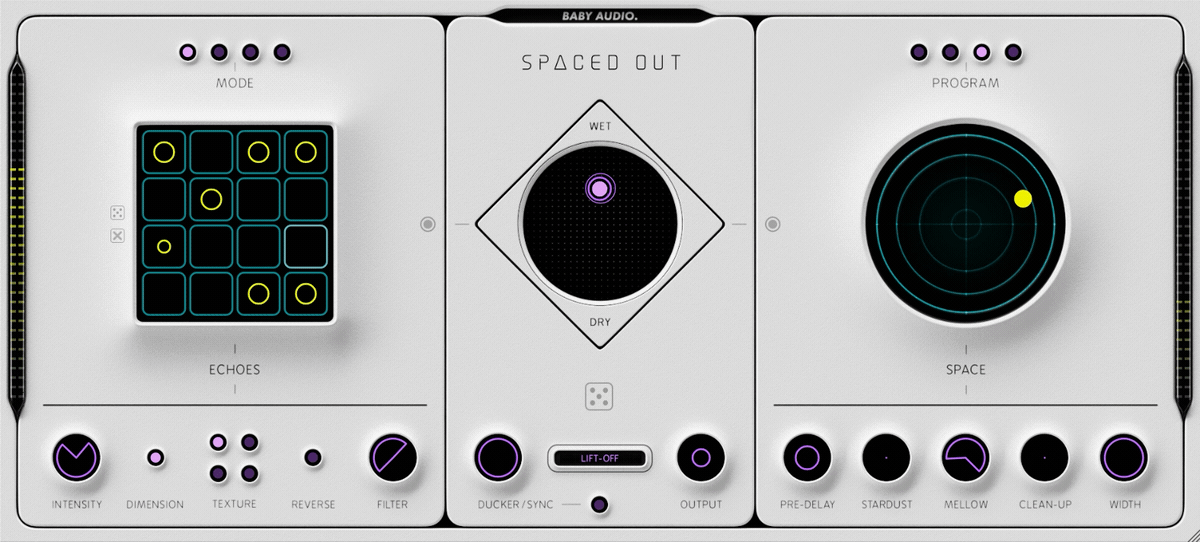
Although, Baby may have liked the idea of creating a modern RE-201, the truth is Spaced Out is really nothing like the Roland unit, nor does it share any of its signal flow. And this is a good thing. The industry certainly doesn’t need another clone or rehash.
What Spaced Out does provide is an easy-to-use, environment for creating deep, lush ambiences that is very well-suited for laid back, lo-fi, and chill, as well as Big Room breakdowns. There are a handful of presets available, but there is not much to get excited about, especially since the interface begs, begs, to be tweaked in order to dial in just the right density for your compositions. Baby Audio even promotes this exploration by providing randomization features to discover new sonic worlds without having to manipulate every control.

Starting from left to right, there are three modules, Echoes, Central Mixer and Space. Echoes contains a 16-step, delay sequencer with four modes, Straight, 2X, Dotted and Triplet. Across the bottom is Dimension, Texture, Reverse and Filter. The 16-step sequencer is represented by boxes in a four by four grid. Each box details three states, 100% — 50% — Off, for the beat-synced echoes. As mentioned above, there is a randomization feature for the boxes, represented by a dice, that auto fills the boxes if you want Spaced Out to determine the three states for you. Once your boxes are determined, you can then set the Mode, which works best for your material.
If there was a gripe about the Echoes module, it would be Intensity and Filter functions on the bottom. The Filter is depicted by some sort of pie-chart that contains the low and high-pass action. There are two hands of a clock, one for each, but no indication of where they are in the frequency range. Worse, is that since the pie-chart is tiny, it’s rather cumbersome to use. It’s a shame because you can truly shape the delay here, but it becomes aggravating to employ to some degree. A couple of sliders would have been a better choice. The annoyance isn’t so bad with Intensity, but again, a slider may have been a better choice here.
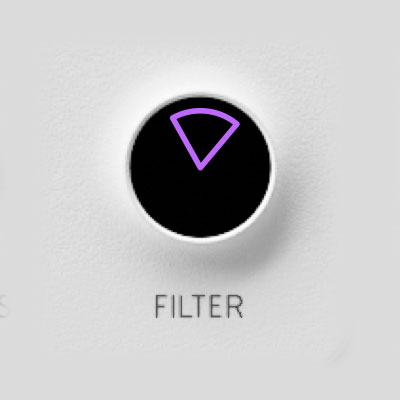

The easiest way for electronic musicians to get their music onto Spotify, Apple Music, iTunes, Amazon Music, Tidal, Instagram, Facebook, TikTok, Pandora, Twitch & much more! Click the banner above or the Go Button to save 7% off of your signup! GO!
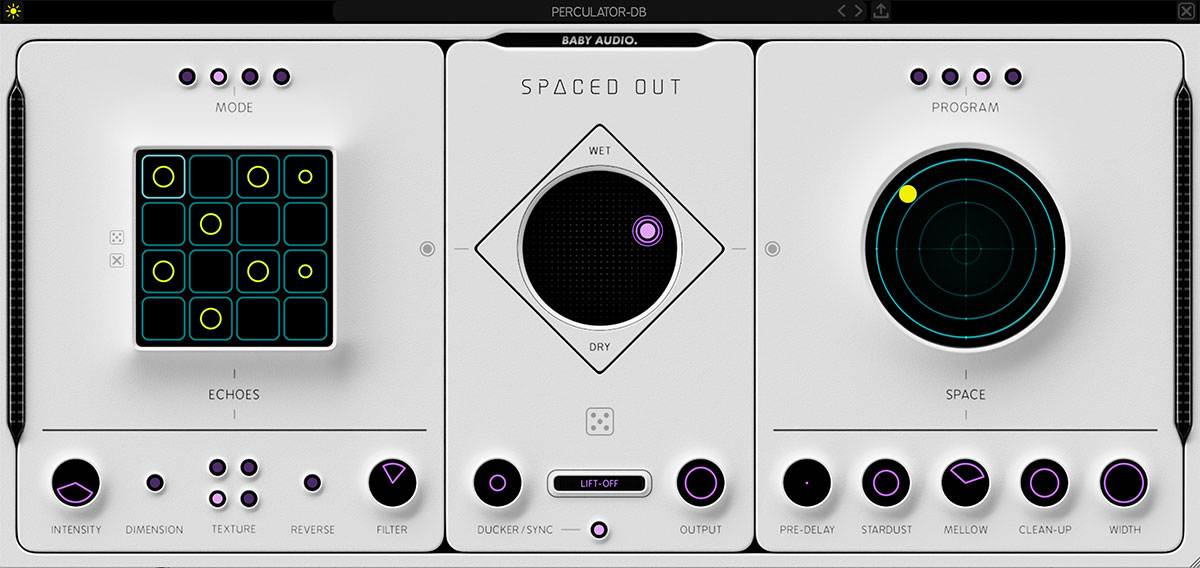
Reverse is self-explanatory, but Dimension could have been expanded, especially in the motion area. Nothing as elaborate as Brauer Motion by Waves, but certainly some more attributes could have been added for better control over the pan of the delay. The Texture feature has a nice impact with Wonky Tape and LoFi adding some of that pitch fluctuation that has fueled scores of tape loop Instagram accounts.
The Central Mixer provides a joysticky control for dialing in a balance of wet/dry and echoes/space Just below is another randomization button for generating musically-tuned effect combinations. Lift off, has nothing to do with launching the signal. It’s basically a summing feature that funnels the sound through a stew of mid-side processing, EQ and compression. The Ducker simply “ducks” the processing when the original sound is is present, but Ducker Sync times the Ducker to your digital audio workstation’s BPM for a Chainsmokers vibe, albeit much tamer.
Baby Audio Spaced Out Data:
- Plug-in formats: VST, VST3, AU, AAX
- Platforms supported: Mac OS 10.7 and up including Catalina and Big Sur. PC Windows 7 and up
- DAWs supported: Ableton Live, Pro Tools, Logic Pro, FL Studio, Cubase, Nuendo, Reaper, Reason + more
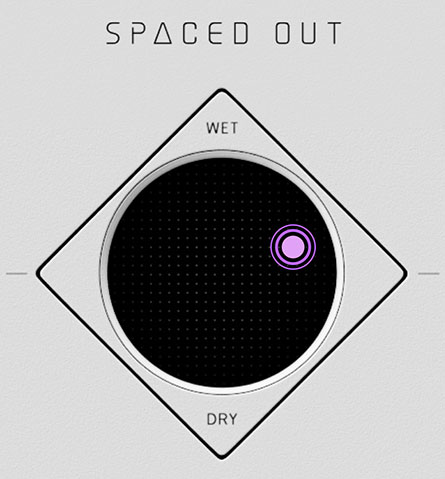
Spaced Out looks to be the software equivalent to Eventide’s Blackhole or Death By Audio’s Rooms to bathe your sound in delicious and lavish reverb, bordering on opulent. It contains a pre-delay, up to 250 milliseconds, and four different arenas, Vacuum, Small Space, Medium Space and Outer Space. By all accounts, Baby Audio’s version of a Small Space is a lunar landing, so you can just imagine what Outer Space gives you.
Baby Audio realizes that things can get out of hand – quickly – so it provides a couple of features to ratchet things down when you find your audio drowning in the abyss. First is Mellow, which offers a high/low end dampening filter. Next is Clean-Up. This “feeds an altered dry signal into the reverb algorithm for a cleaner and less dense response.” Wait. What?? Yeah, the Babies just inserted this line in their features section without much of an explanation, so we asked for a bit more detail.
“What happens is there’s a transient shaper applied to the wet signal before it hits the reverb (without affecting the dry signal),” states Baby Audio’s Caspar Bock. This shaper trims down the signal that is being fed into the reverb, especially the sustain of it. What that means – in practice – is you’ll get a less dense reverb tail that feels lighter and more “airy.”
Stardust adds a nice texture to the reverb tail for added depth. It’s subtle, but provides an extra dimension that works great for very simple sounds, including piano. All in all, Baby Audio claims that 50 individual effects are running on mini treadmills under the hood of Spaced Out. You could never tell by the interface, but the sound certainly reflects all that juice.
Conclusion
For forty bucks, Baby Audio’s Spaced Out is a winner. It’s not perfect and could use some attention to the interface, especially by replacing the pie-charts with more conventional mechanics, as well as ticking some other boxes – see The Future below. In Baby Audio’s defense, they acknowledged, the pie-chart metaphor was “to preserve space on the GUI and make the process more intuitive. With Spaced Out, in general, we tried our best to embrace the fact that this is not a physical object but a screen-based interface. We love to experiment with what a control should look like on a screen — and hopefully come at it from a fresh angle.” We salute what they accomplished entirely in-house. Fact is, the plug-in is Baby Audio’s most attractive to date – a cross between Native Instruments’ Massive X and HAL, the naughty computer from 2001 – A Space Odyssey. Overall,it’s got a lovely, yet expansive sound and will certainly be a favorite for anyone creating music in the ambient, experimental and chill genres. Recommended.
Rating: 88%
Cheers:
+ Big Value
+ Savory & Luscious Reverb
+ Elegant Interface
+ Plays Well With Both Guitars & Synths
+ Randomization
+ Fun To Explore
Jeers:
– Meh Presets
– Pie-Chart User Interface
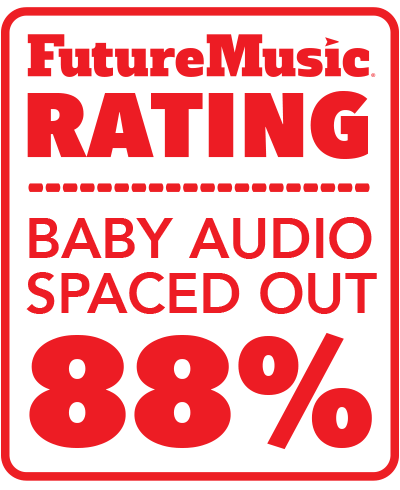
Baby Audio’s Spaced Out costs $69.99 ($39.99 Special Intro Price) and is available now.
The Future: Well for Baby Audio’s Really Spaced Out version 2.0, we’d of course like to see those pie-chart interfaces get jettisoned in place of more conventional sliders with frequency designations. However, maybe the Babies can come up with something that still saves space and is attractive, but is a tad more usable. We have a feeling that the company may be enamored with them, so maybe by clicking a toggle, the interface can fold out giving the user access to more detailed parameters. The Motion feature is crying out for more attention. Maybe break this out into something called Orbit to allow intricate, BPM-synced panning that also has depth. Stardust is another cool reverb feature that would be fun to explore further.








